- Contents
- The Evolution of Social Media Influencers:
- Most Frequently Used Social Media Platforms
- Which types of influencers do most people follow
- Which category of influencers do most people follow
- Do people trust the recommendations made by influencers?
- The most believable influencers
- Influence in buyers’ decisions
- You have been Unfollowed by…
- Top Influencers in Kenya and Nigeria in 2023
In the ever-evolving landscape of the digital age, social media influencers have emerged as critical players in shaping consumer trends, brand perceptions, and online culture. Some influencers have a couple thousand followers, while others have several million. Regardless of the size of their “influence,” an influencer has a privileged position in the eyes of several individuals online.
The Evolution of Social Media Influencers:
According to PLNU Viewpoint, the concept of “social media influencer” is versatile, encompassing individuals who can inspire actions among their followers.
Social media Platforms like Facebook, Instagram, YouTube, TikTok, and Twitter have become the playgrounds where influencers showcase their lives, talents, and preferences.
To understand how people around Africa think about social media influencers, GeoPoll surveyed– Kenya and Nigeria– in October and November 2023 with a sample size of 1,466 participants. This report provides an in-depth and updated insight analysis of social media influencers in Africa. Our previous report findings can be found here.
This report highlights key aspects, including:
- Most used social media platforms
- Which types of influencers do most people follow
- Do people trust influencer reviews/recommendations?
- The types of influencers most people find to be most believable.
- Does an influencer review or recommendations influence buying a product or service?
- Most influential influencer content type
- Reasons why people unfollow or stop engaging influencers.
Most Frequently Used Social Media Platforms
Africa’s most used social media platform is Facebook, with a staggering 170 million users. This platform’s ubiquity spans cultures and languages, making it a bridge for connecting people across diverse backgrounds.
From the latest findings, Facebook is the king of active users, boasting 22.68% of participants actively using the platform to follow influencers. YouTube closely followed with a significant 17.95% active user rate. The new and popular TikTok captured the attention of 16.95% of participants, highlighting its status as a preferred platform for short-form visual content sharing. Instagram secured an active user percentage of 15.54%, while Twitter followed with 14.60% users, and Snapchat has a 6.8% active user base. She was followed closely by blogs with 3.42%. 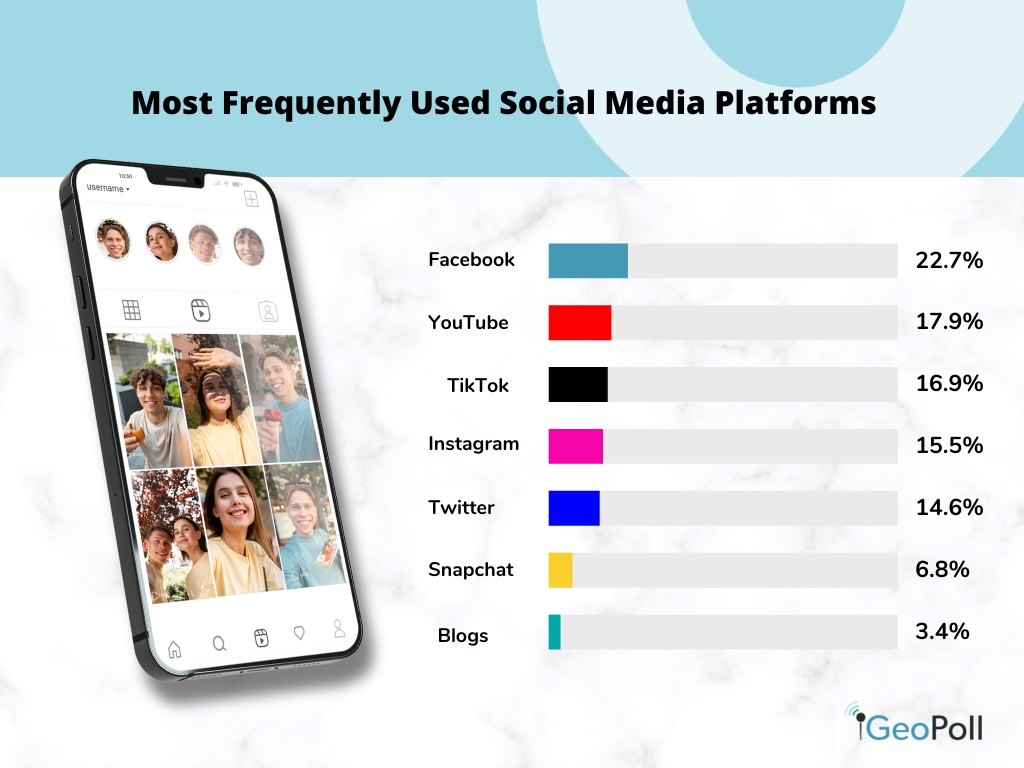
Which types of influencers do most people follow
According to the survey findings, 94.87% of participants actively follow social media influencers, while a minimal 5.13% don’t follow any. Moreover, the breakdown of participant preferences reveals that 45.29% follow over ten influencers, 26.95% follow up to 5, and 25.94% follow 5 to 9 influencers.
The data also provides insights into the types of influencers most participants follow. Celebrities, including musicians and actors, have a 23.08% following. Journalists and media influencers follow closely at 18.01%, and experts in specific fields, such as fashion designers, garner a notable 16.20% following. Social media sensations capture the attention of 14.89% of participants, while regular social media users and bloggers/vloggers secure 14.20% and 13.63% of the participant following, respectively. 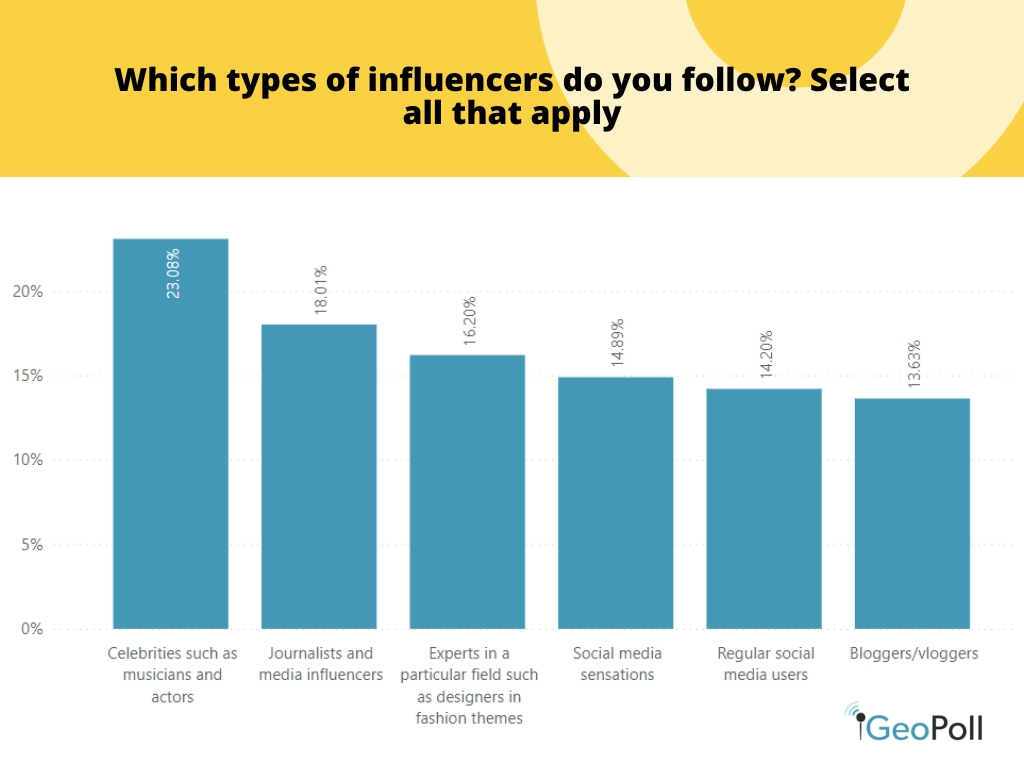
Which category of influencers do most people follow
The survey outcomes unveil intriguing insights into the diverse landscape of influencer preferences. Lifestyle influencers – such as parenting and family, command a leading position, capturing the interest of 18.17% of users. Following closely, fashion influencers with a notable niche of 15.84% following. Tech influencers secured a substantial 15.26% audience. Politics also proves influential, as political influencers engage 14.88% of users. Food influencers attracted 13.14% of followers, while travel influencers captured 12.54%. Additionally, gossip influencers contribute to the entertainment landscape, garnering the attention of 9.17% of users. 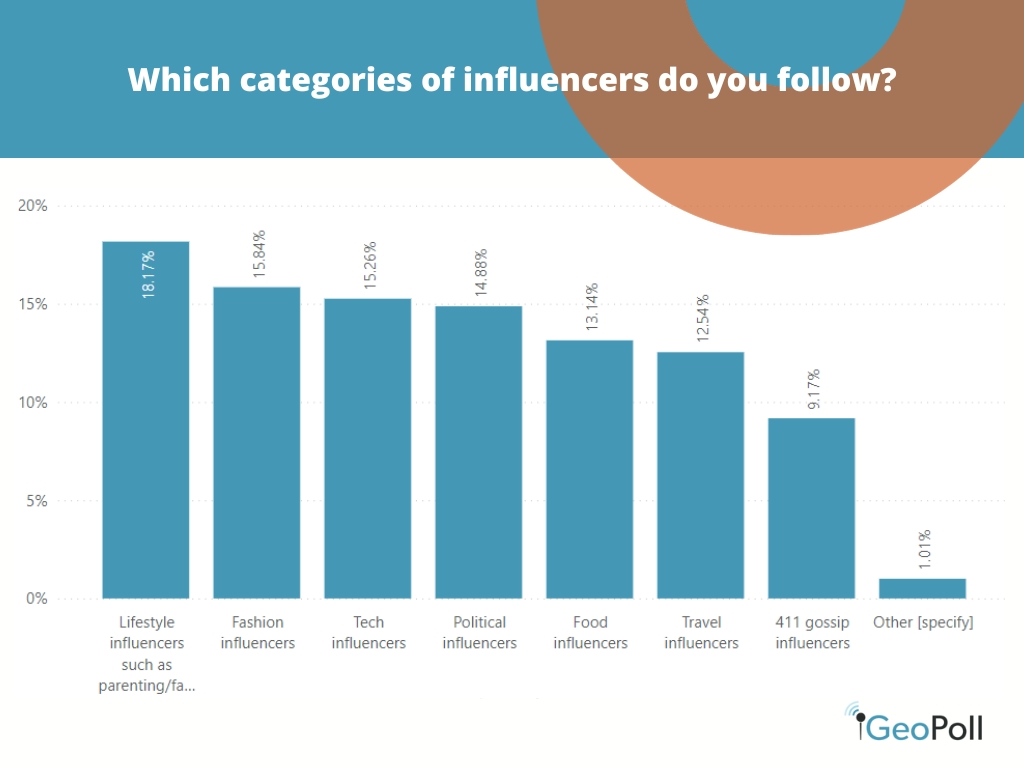
Do people trust the recommendations made by influencers?
People’s trust in influencer reviews and recommendations is complex, as shown in a recent survey.
A significant 46.89% of respondents consistently trust influencer opinions, relying on their recommendations regularly. Meanwhile, a slightly higher percentage, 47.96%, falls into the category of those who sometimes trust influencer content, suggesting a variable level of reliance depending on the context or influencer. Interestingly, a tiny 5.15% of participants do not trust influencer reviews. 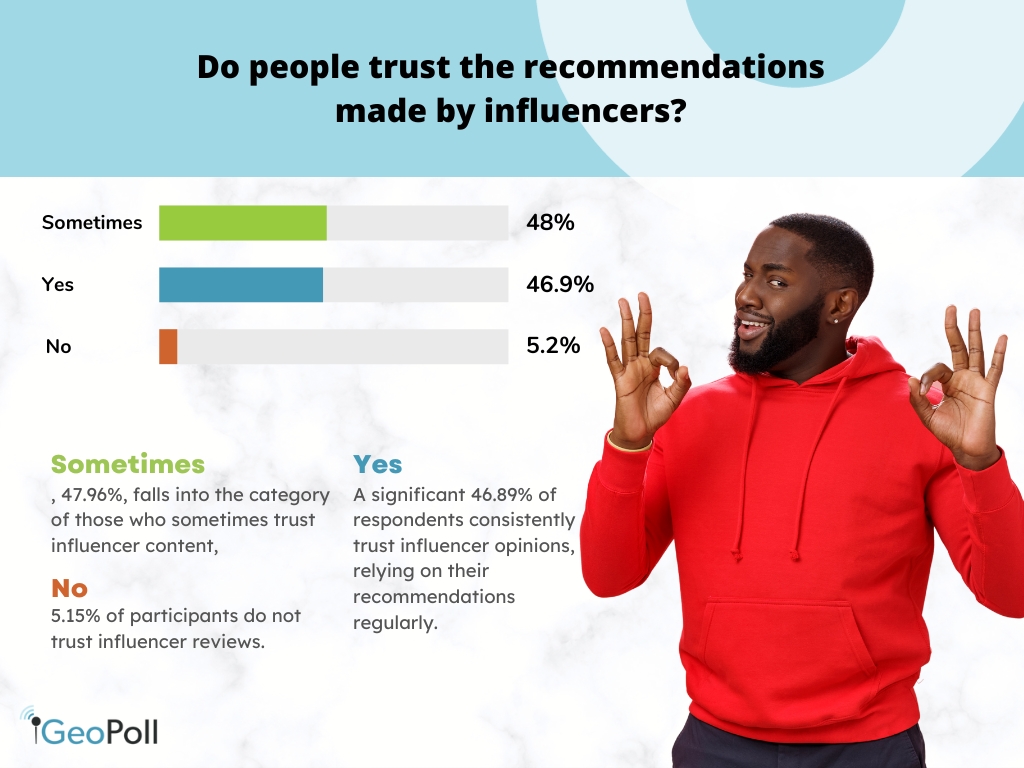
The most believable influencers
In the 2020 study, we saw that the most believable types of influencers were journalists and media personalities (51%), who came on top, followed by industry experts (46%) and celebrities such as musicians and actors at 44%. However, the lest data places experts in specific fields, like designers in fashion themes, as the most trusted, commanding the belief of 23.71% of participants. Following closely, journalists and media influencers garnered a significant 23.27% trust. Celebrities, including musicians and actors, were believed by 17.59% of the participants, while social media sensations earned the belief of 13.41%. Regular social media users were trusted by 11.55%, and bloggers/vloggers received the trust of 10.47% of the respondents. 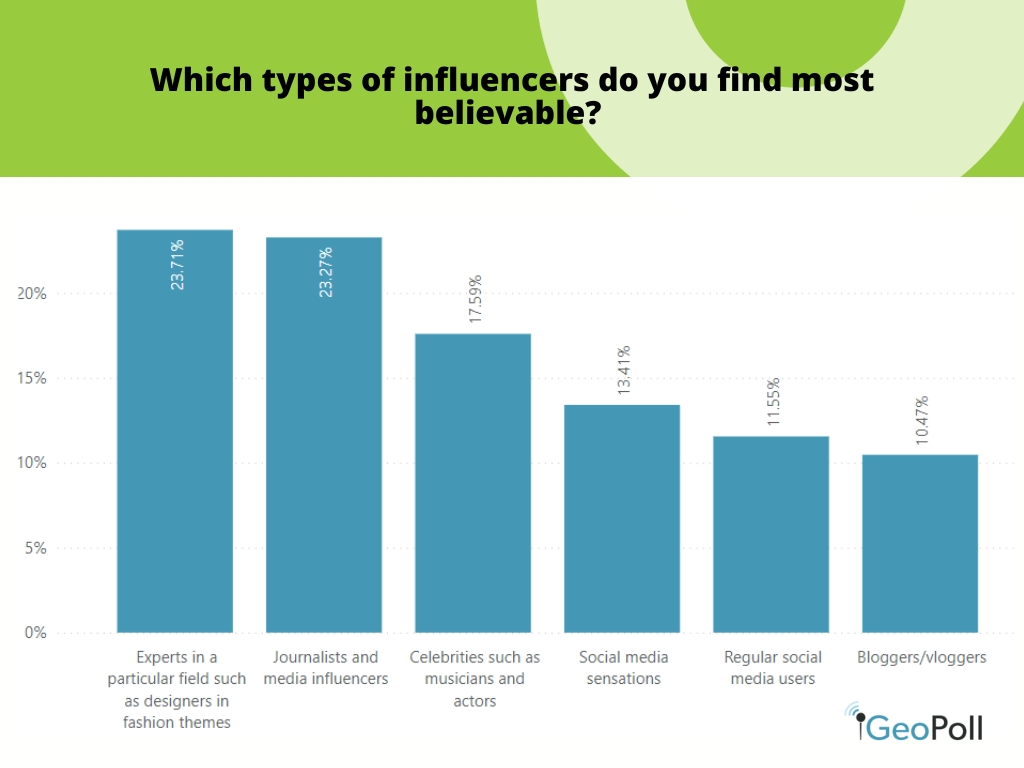
Influence in buyers’ decisions
The rise in social media influencers has led organizations and companies to promote their products and services through these digital personalities. Notably, 80.39% of participants have purchased products or services advertised by influencers. Conversely, 19.61% of respondents have not purchased based on influencer advertisements. 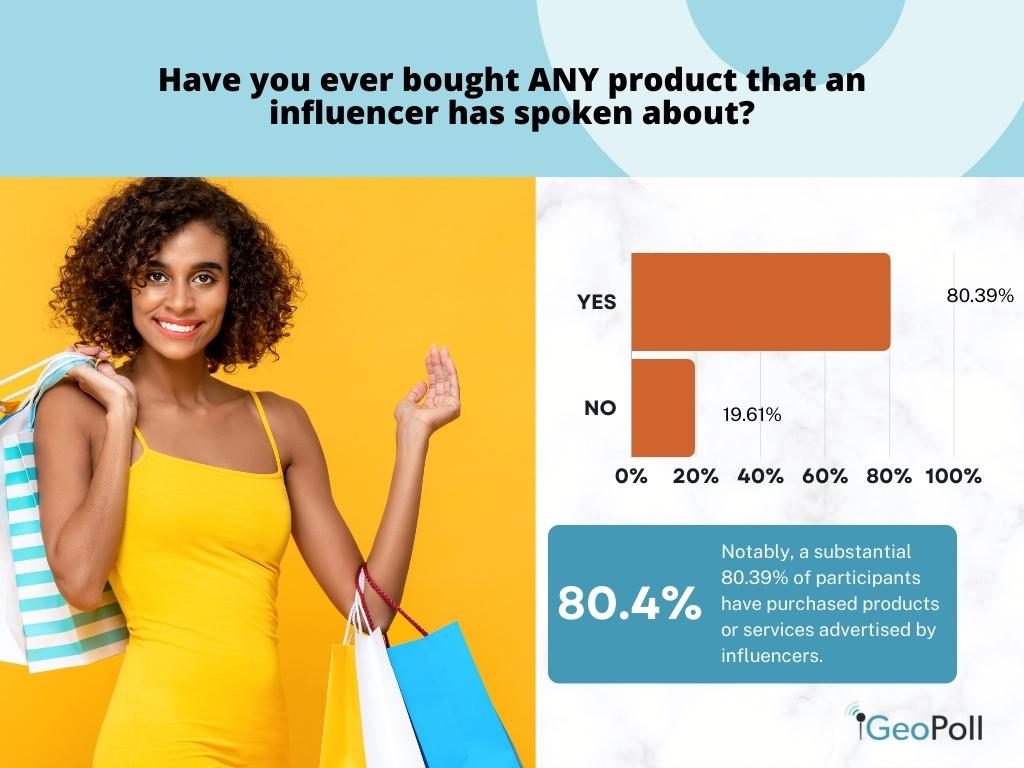
You have been Unfollowed by…
Several reasons lead to users no longer following another person or an influencer on social media; 50.09% of the participants have never unfollowed an influencer; however, 49.91% have unfollowed an influencer.
Our findings revealed various reasons for participants’ non-following influencers. A notable 17.55% lost trust in the influencer, leading to their decision to unfollow. Additionally, 16.75% cited the influencer’s diminished relevance as a factor for their decision to unfollow. Offensive and controversial content proved to be a significant reason, with 16.58% unfollowing for this reason. Boring content led to 14.82% of participants unfollowing, while 13.69% decided to unfollow due to a shift in the influencer’s content focus. 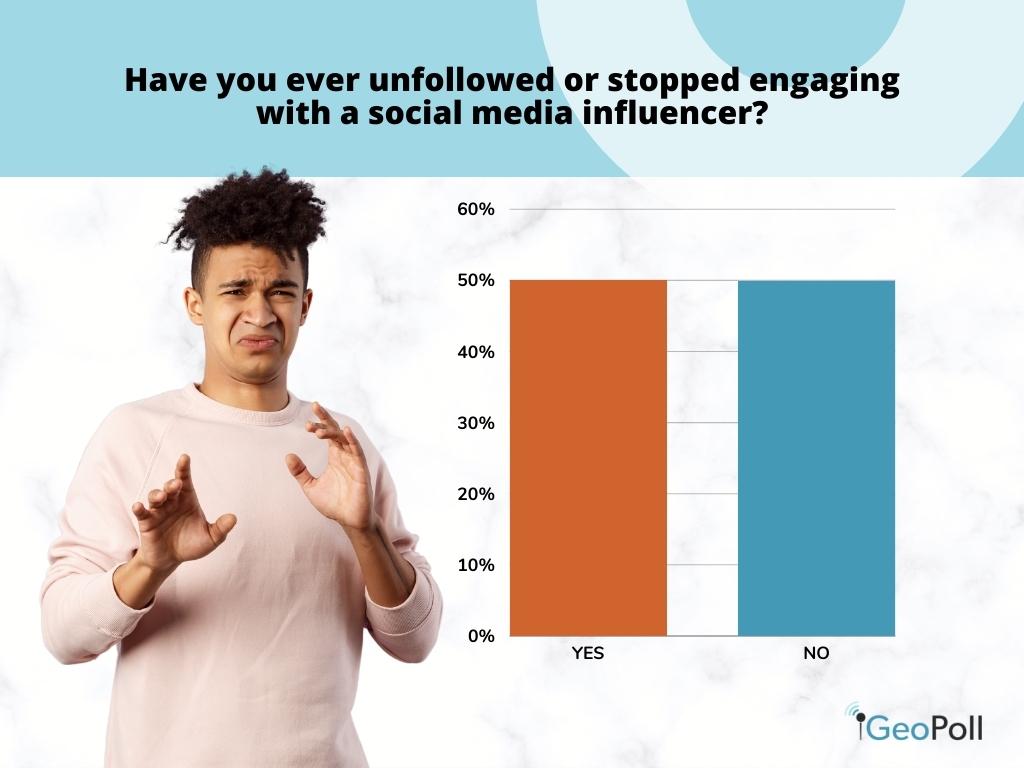
Top Influencers in Kenya and Nigeria in 2023
So, who are the top influencers in the two countries? We asked the respondents to name their favorite influencers from the top of their memories. We curated all the names provided into a list of the top 15 mentions in each of the countries.
Top 15 influencers in Nigeria
| Influencer | %Mention | |
| 1 | Davido | 18.2% |
| 2 | Wiz Kid | 9.4% |
| 3 | Ali Nuhu | 8.6% |
| 4 | Tiwa Savage | 7.0% |
| 5 | Linda Ikeji | 4.8% |
| 6 | Burna Boy | 4.0% |
| 7 | Don Jazzy | 4.0% |
| 8 | Mercy Johnson | 3.8% |
| 9 | Aproko Doctor | 3.5% |
| 10 | Tunde Ednut | 3.5% |
| 11 | Brain Jotter | 3.5% |
| 12 | Olamide | 3.2% |
| 13 | Mr Macaroni | 3.2% |
| 14 | Simi | 2.9% |
| 15 | Sabinus | 2.7% |
Top 15 influencers in Kenya
| Influencer | %Mention | |
| 1 | Bahati | 10.1% |
| 2 | Azziad | 9.6% |
| 3 | Diana Bahati | 7.0% |
| 4 | Crazy Kennar | 6.0% |
| 5 | Eric Omondi | 5.8% |
| 6 | Njugush | 5.4% |
| 7 | Andrew Kibe | 4.0% |
| 8 | Abel Mutua | 3.9% |
| 9 | Thee Pluto | 3.7% |
| 10 | Size8 | 3.6% |
| 11 | Flaqo | 3.6% |
| 12 | Akothee | 3.3% |
| 13 | Ajib Gathoni | 3.3% |
| 14 | Vera Sidika | 3.2% |
| 15 | Churchill | 2.9% |
Methodology/About this Survey
This Exclusive Survey was run via the GeoPoll mobile application between 24th October and 27th of November 2023 in Kenya and Nigeria. The sample size was 1.466, composed of random app users between 18 and 60. Since the survey was randomly distributed, the results are slightly skewed towards younger respondents.
Please get in touch with us to get more details about exclusive GeoPoll surveys, conduct a scientific study of social media influencers, or other topics in Africa, Asia, and Latin America.
